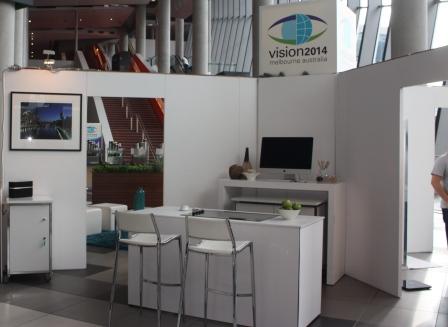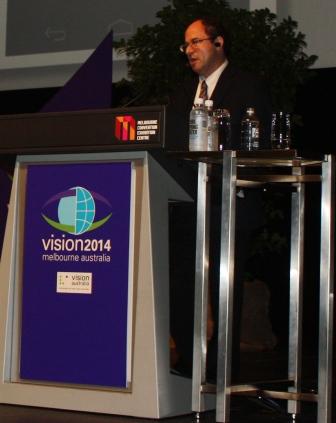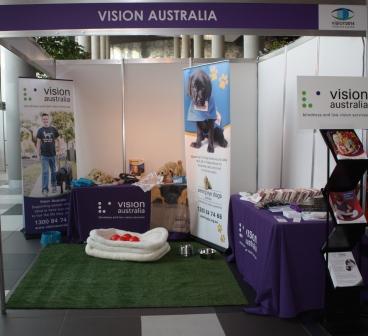Last week, more than 600 low vision researchers and practitioners from countries such as Hong Kong, Nigeria, the Netherlands, Italy, Scandinavia, Canada and the USA, New Zealand and Australia, Japan and India, gathered in Melbourne for Vision2014, the 11th International Conference on low vision.
The Conference, which was officially opened by Major General The Honourable Michael Jeffery, was themed Advancing Research, Upgrading Practice and Improving Participation. And, with more than 200 presentations from researchers, clinicians, rehabilitation practitioners and people living with low vision, there was plenty of opportunity to share knowledge and learn from colleagues in the industry.
It was a great development opportunity for more than 40 Vision Australia staff who attended as either day or full delegates. In addition, more than 20 staff presented their own research and papers during the symposia or poster presentation sessions.
A highlight of the event was the presentations from the people living with blindness and low vision. Seven speakers, aged between four and 92 shared their personal stories about how low vision affects their lives. It reminded delegates of the need to listen early and listen regularly.
One such speaker, Vision Australia’s Coordinator of Volunteers, Rolf Geerlings, challenged attendees at the Australian Eye Care Professionals Breakfast, to listen for the tears behind the smiling eyes and to offer patients information about the full range of rehabilitation services that are available for them to access.
 Another major attraction was the innovative iHouse. Split into four living zones, the iHouse demonstrated the use of mainstream technology to create an accessible living space, for example, a talking iPhone app that can tell you the colour of your clothes hanging in a wardrobe.
Another major attraction was the innovative iHouse. Split into four living zones, the iHouse demonstrated the use of mainstream technology to create an accessible living space, for example, a talking iPhone app that can tell you the colour of your clothes hanging in a wardrobe.
 David Green presented the first plenary session titled Accessible and Sustainable Low Vision Eye Care. David’s philosophy is to maximise distribution while being profitable. This means removing elements or practices from manufacturing or delivery processes that do not add value in order to keep costs down and implementing pricing structures that enable customers to pay what they are able to afford for the service or surgery. In many cases this means free or below cost services.
David Green presented the first plenary session titled Accessible and Sustainable Low Vision Eye Care. David’s philosophy is to maximise distribution while being profitable. This means removing elements or practices from manufacturing or delivery processes that do not add value in order to keep costs down and implementing pricing structures that enable customers to pay what they are able to afford for the service or surgery. In many cases this means free or below cost services.
On the last day, Penny Hartin from World Blind Union, presented a look to the future, with an overview of the Vision Alliance Policy paper, due to be finalised this year, and highlighted the key objectives of that policy including raising awareness and encouraging and sharing research. In addition, Professor Jill Keefe, from the Centre for Eye Research Australia, provided an in-depth review of the global burden of low vision. And, finally Bob McMullan challenged conference delegates to identify where they can be most effective at getting the global action plan for the prevention of avoidable blindness and visual impairment implemented at a national level.
In the coming weeks, all of the key note presentations will be made available on the Vision2014 website along with the speaker abstracts.
As with any conference of this size and complexity, it requires a strong team effort to make it happen and much work went into ensuring best practice accessibility for supporting materials.
In addition, Vision Australia was proud to showcase the use of Quick Response (QR) codes, which could be scanned with QR readers and indicated the room schedule for the day. There was good feedback received about the usfulness of this type of signage from delegates who are blind or have low vision.
Congratulations to the Conference Organising Committee, Maryanne Diamond, Meg Bishop, Sandro Cirianni (Guide Dogs Vic), Ron Hooton, Ass. Prof. Jonathan Jackson (Australian College of Optometry), Prof. Jan Lovie-Kitchin, Prof. Olga Overbury (University of Montreal) and David Speyer.
 And a big thank you to the 130 volunteers who assisted conference delegates throughout the duration of the event, and Vision Australia staff and volunteers who assisted in coordinating and supporting the Vision Australia stand as part of the conference exhibition.
And a big thank you to the 130 volunteers who assisted conference delegates throughout the duration of the event, and Vision Australia staff and volunteers who assisted in coordinating and supporting the Vision Australia stand as part of the conference exhibition.
Vision Australia hopes that this international conference will improve the participation of those with low vision in designing their own services and encourage more practitioners to participate in low vision care and research with the ultimate goal to enable people who are blind or have low vision to live the lives they choose.










